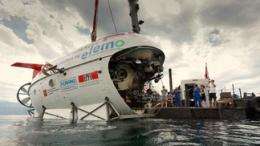A MIR Submersible in 2011. Credit: EPFL/Jean-Marc Blache
One year after the MIR submersibles dove into the depths of Lake Geneva, the elemo program is delivering its first scientific results. And with the support of Ferring Pharmaceuticals, the operation will be extended with a campaign to make observations above the lake surface from a sensor-packed ultralight aircraft. The same experiments are planned above Lake Baikal in Russia.
In summer 2011, two Russian submersibles explored the depths of Lake Geneva as part of the scientific observation program elemo. Preliminary results are just now coming in. At the same time, EPFL and Ferring Pharmaceuticals, sponsor of the elemo program, are announcing a new installment of the exploration. This time, the scientists will make their observations from the air. Starting in late November, they'll fly aboard ultralight planes to measure phenomena occurring at the interface between the air and water. Federal authorities have given their authorization for the flights. This scientific mission will be repeated over Lake Baikal in Russia.
On board the submersibles: preliminary results
The elemo program has already delivered preliminary results that have been extremely useful for assessing the health of the lake and for better protecting its ecosytem. Research is currently being done on pollution, the flow dynamics of currents, the bacterial fauna in the lake and the geology of the lake bottom.
Several scientific teams have already begun to publish research results; articles in peer-reviewed scientific journals should start to appear in the coming months and years. Data gathered from the MIR submersibles has enabled scientists to demonstrate a correlation between the presence of certain bacteria and heavy metals. They were also able to precisely measure how micropollutants – primarily pesticides or pharmaceuticals – spread throughout Lake Geneva from water treatment station outlets.
Elemo takes to the air
On board their two ultralights, scientists from EPFL, Eawag and CEA (France) will study phenomena occurring near the surface of the lake, as well as the influence of air currents on the lake. Test flights will take place above the Lausanne and Nyon regions between November 26 and December 5, to test and calibrate the sensors. The official research campaign will begin in May 2013.
The scientists will use a "hyper-spectral" camera, a tool that allows them to decompose the light spectrum into hundreds of separate colors. From this, they can obtain an global image of certain elements close to the surface of the lake, such as bacteria, sediments, and dissolved gases. This kind of analysis is already done by satellites, but technical limitations (they can only separate a few parts of the light spectrum) and distance make many kinds of observations impossible.
At the same spot where the camera is pointed, a catamaran will simultaneously take water samples. By comparing the data taken from the air and from the water, the scientists hope to be able to develop new and better methods for analyzing the currents and the overall health of the lake.
For Michel Pettigrew, President of the Executive Board and Chief Operating Officer de Ferring Pharmaceuticals, a continuation of the company's support of the program was self-evident. "Ferring has a keen interest in science and the environment and is especially committed to the Lake Geneva region. As a member of the local community, we are particularly proud to support the elemo project, which brings the best international scientific teams together with the objective of advancing our understanding the dynamics of Lake Geneva."
As in the 2011 exploratory campaign on board the MIR submersibles, this extension of the elemo program will also continue in Russia, above the waters of Lake Baïkal – the world's deepest lake – under the name "Project Léman-Baïkal." By comparing results obtained in Switzerland and Russia, the scientists will be able to consolidate their knowledge and the methods they use to study lake environments.
More information: www.elemo.ch/
Provided by Ecole Polytechnique Federale de Lausanne






















